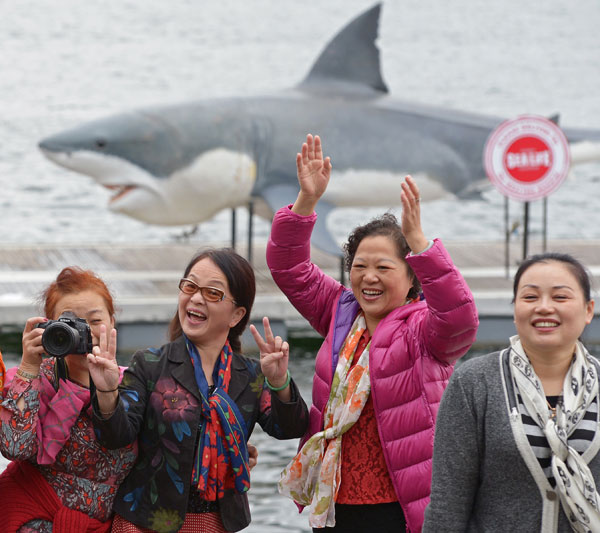 |
|
Chinese tourists pose for photographs in front of a 7.4-meter-long great white shark replica in Sydney Harbour in November. Chinese overtook US citizens as the world's biggest-spending travelers in 2012. Greg Wood / for China Daily |
China had the highest number of outbound tourists and amount of overseas spending in the world last year, according to a report released on Wednesday.
Ninety-seven million Chinese traveled abroad in 2013, beating the 2012 mark by roughly 14 million, according to the China National Tourism Administration. The number is expected to surpass 100 million this year.
The report released on Wednesday by the Tourist Research Center of the Chinese Academy of Social Sciences said that China's tourists have had the world's strongest purchasing power since 2012. They overtook German and US tourists as the world's biggest-spending travelers in 2012, spending $102 billion overseas, a 40-percent increase from 2011.
Most Chinese tourists traveled to Asian and European countries, the report said, accounting for 75 percent of overseas tourists in those countries.
Song Rui, director of the center, said the 2013 figures for overseas spending have yet to be released, but there will "definitely" be a new record by Chinese tourists.
"Chinese tourists spend so much abroad that some foreigners are calling us the 'walking wallets', " Song said, who added that Chinese travelers who purchased luxury products during the 2012 London Olympics led Britons to coin the term "Peking Pound" for Chinese spending power.
The report said Chinese tourists spent on average $7,107 per person during their trips in the US in 2011. The average amount of spending by a tourist in the US that year, according to the US Commerce Department, was $2,440.
With increased spending and traveling by Chinese travelers, more travel service providers in foreign countries are adjusting their business models. Hotel groups, including Hilton Worldwide and Starwood Hotels & Resorts Worldwide, have designed new services specifically for Chinese customers.
By August 2013, all of Hilton's hotels worldwide were providing a service called "Hilton Huanying" that provides Chinese tea pouches and teapots in guestrooms. Chinese food is also being served in its hotels.
Nineteen of Starwood's hotels around the world are able to provide services in Mandarin and offer chopsticks during meals.
The report quoted executives from several overseas hotels as saying that China has been targeted as their "second-largest" market since 2010.
A few hotels have localized their brands in China. In 2012, Accor renamed its Grand Mercure hotel in Shanghai as Mei Jue. InterContinental Hotel Group designed a new brand called Hualuxe Hotels & Resorts for its customers in China.
Wei Xiao'an, a director at the World Tourism Cities Federation, said Chinese tourists should pay more attention to their behavior and respect the local customs while traveling abroad.
Tourism within China has also grown over the past year. The country hosted 3.2 billion tourists in 2013, according to the Tourist Research Center report, beating 2012's mark by 300 million.
Sanya, Hainan province, was the most popular travel destination in China last year.
yangwanli@chinadaily.com.cn
|
|
|
|
|
|
|
|
